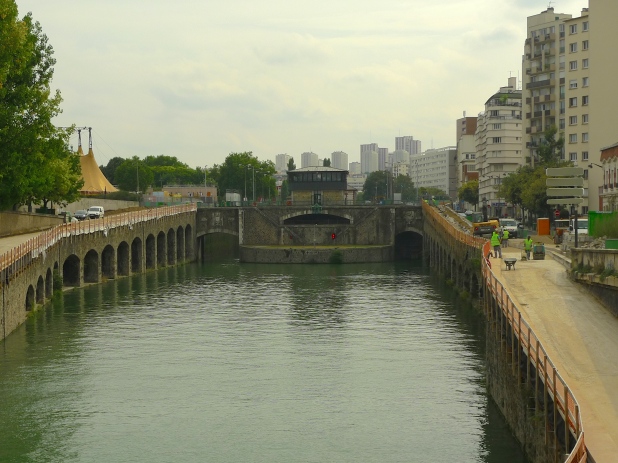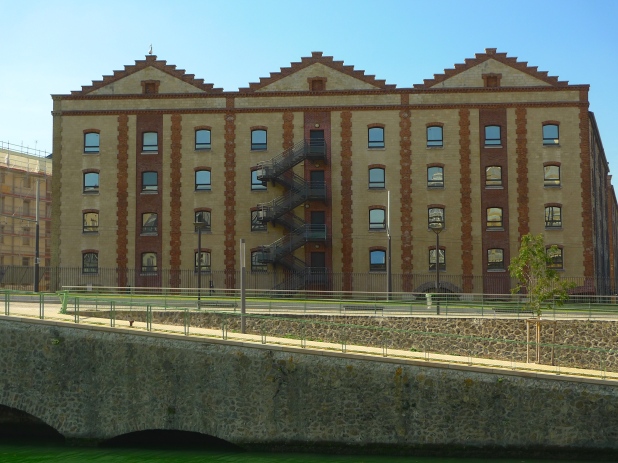The Canal Saint-Denis and its Sounds – Part 1
ALONG WITH THE Canal de l’Ourcq, the Bassin de la Villette, the Canal Saint-Martin, and the Bassin de l’Arsenal, the Canal Saint-Denis is part of the 130 km Réseau des Canaux Parisiens – the Parisian Canal Network.
The Canal Saint-Denis looking from l’Écluse du Pont de Flandre to the Pont de Flandre
The Canal Saint-Denis links the Canal de l’Ourcq at the Parc de la Villette in the 19th arrondissement to la Seine in the commune of Saint-Denis, 6.6 km to the northwest. From the Canal de l’Ourcq to la Seine the canal navigates seven remote-controlled locks and one remote-controlled swing bridge and it drops some 28 metres.
The route of the Canal Saint-Denis from the Canal de l’Ourcq to la Seine showing the locks, or ‘écluses’ in French
The canal is 3.2 metres deep at its shallowest point and 3.5 metres at its deepest and its width varies from 30 metres to 140 metres. It can accommodate vessels with a beam of up to 8 metres and a maximum displacement of up to 1,000 tons. It takes about two and a half hours for vessels to navigate the full length of the canal.
Like the Canal de l’Ourcq, the Canal Saint-Denis was born in the mind of Napoleon Bonaparte. Both canals were intended to provide an efficient means of communication for provisioning Paris but whereas the Canal de l’Ourcq was also intended to provide Paris with a plentiful supply of water, the Canal Saint-Denis was designed as what we might think of today as a ‘by-pass’, a means of reducing the number of ships and barges passing through the centre of the city. As well as being a by-pass for river traffic the Canal Saint-Denis was, and still is, a by-pass for water. By diverting excess water from the Canal de l’Ourcq to the Seine, the Canal Saint-Denis serves to maintain constant water levels in Paris’s canals thereby helping to prevent flooding.
The building and operating of the Canal Saint-Denis was achieved through what we would now call a public-private partnership. The City of Paris purchased the land and then tendered contracts to private banking firms requiring them to build and operate the canal in return for which they were permitted to collect tolls from traffic using the canal for a term of ninety-nine years.
Work on the Canal Saint-Denis began in 1805 under the supervision of the French ingénieur des ponts et chaussées, Édouard de Villiers du Terrage, and it opened in May 1821, on time and, at an estimated six million Francs, under budget.
I’ve been to explore the Canal Saint-Denis by walking from one end to the other and in this and in subsequent blog pieces I will share with you what I observed.
I began at the beginning, where the Canal Saint-Denis parts company from the Canal de l’Ourcq at the Parc de la Villette and runs alongside the Quai de la Gironde.
The green arrow runs along the Quai de la Gironde. The large rectangular building on the right is the Cité des Sciences et de l’Industrie, the Museum of Science and Industry
The intersection of the Canal de l’Ourcq and the Canal Saint-Denis at the Parc de la Villette
Not only is the Parc de la Villette a large green space (at 35.5 hectares it’s the third largest park in Paris) it also houses one of the largest concentration of cultural venues in Paris, including the Cité des Sciences et de l’industrie (Museum of Science and Industry), three major concert venues and the prestigious Conservatoire de Paris.
The beginning of the Quai de la Gironde
From my starting point at the head of the canal, I had the beginning of the Quai de la Gironde on my left and the entrance to the first lock on the Canal Saint-Denis, l’Écluse du Pont de Flandre, on my right.
The start of the Canal Saint-Denis and the entrance to l’Écluse du Pont de Flandre. On the right is the Cité des Sciences et de l’Industrie and the circus Big Top of the Cirque Plume
When the Canal Saint-Denis opened in 1821 there were twelve locks along its length. Between 1890 and 1895 the canal was rebuilt to accommodate bigger vessels and the number of locks was reduced from twelve to seven each comprising two adjacent chambers. The largest lock on the canal is the first lock, l’Écluse du Pont de Flandre, with a rise of 10 metres which, when it was built, was a world-record. Today, all seven locks and the swing bridge on the Canal Saint-Denis are remotely controlled from l’Écluse du Pont de Flandre.
L’Écluse du Pont de Flandre
Work is underway to renovate the quays on either side of the canal between l’Écluse du Pont de Flandre and the Pont de Flandre so it was not possible for me to walk close to the water along this stretch. But I was able to walk alongside the canal along the Quai de la Gironde, which has its own history.
In the early nineteenth-century, the Parisian flour and cereals warehouses were limited to the granary at Bastille and the Corn Exchange at Les Halles but with a rapidly growing population new storage facilities became necessary. The area around La Villette was chosen because of its canals, which provided easy and inexpensive transportation. In 1858-1859, two stores docks and additional warehousing capacity were built along the Quai de la Gironde to store flour, starch, grain, oil, alcohol and commodities from the French colonies.
In May 1871, during the last days of the Paris Commune, the warehouses were burned to the ground but they were rebuilt soon after and served Parisians for the next century.
These warehouses alongside the Canal Saint-Denis, together with those at the pont du Crimée and alongside the Bassin de la Villette, were known as the Entrepôts et Magasins Généraux de Paris. Today, they are being redeveloped and turned into up-market office space.
From the Pont de Flandre onwards, both the canal and the Quai de la Gironde take on a different feel. The slow moving, lumbering barges and the occasional leisure craft contrast with the sleek, high-speed (although not high-speed at this point) TGV trains crossing the railway bridge. And the Quai de la Gironde ceases to become a road and is transformed into a paved thoroughfare accommodating both pedestrians and cyclists.
The sleek trams of the fairly recently opened Tram Line 3b pass by on one side …
… while the navette fluviale taking visitors to and from the Millénaire shopping complex further downstream passes by on the other side.
And all the while the sound of construction work echoes in the background as the former Entrepôts et Magasins Généraux are rejuvenated.
It was from here amidst all the redevelopment work that I decided to pause and listen and to record a sound portrait of this stretch of the canal and the Quai de la Gironde.
The Canal Saint-Denis and the Quai de la Gironde – A Sound Portrait:
Next time, I will explore the canal from the end of the Quai de la Gironde to the swing bridge, the Pont Tournant du Canal Saint-Denis, but in the meantime, I will leave you with a view looking back along the canal from the end of the Quai de la Gironde – a very different view from that at its beginning.























Such beautiful discreet sounds, each of them microscopic auditory examples of life in progress in Paris.
Thanks JD.
I’m sure that some sound recordists would not have recorded from here because of the incessant construction work going on. But for me, the sounds of the renovation work on the former Entrepôts et Magasins Généraux seemed to represent the sound of the nineteenth-century actually being dragged into the twenty-first century and so I thought they were worth capturing and preserving.